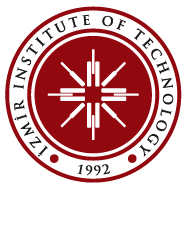Papers in 2023

An appraisal of the local-scale spatio-temporal variations of drought based on the integrated GRACE/GRACE-FO observations and fine-resolution FLDAS model
The gravity recovery and climate experiment (GRACE) observations have so far been utilized to detect and trace the variations of hydrological extremes worldwide. However, applying the coarse resolution GRACE estimates for local-scale analysis remains a big challenge. In this study, a new version of the fine resolution (1 km) Famine early warning systems network Land Data Assimilation System (FLDAS) model data was integrated into a machine learning model along with the GRACE data to evaluate the subbasin-scale variations of water storage, and drought. With a correlation of 0:99 and a root mean square error (RMSE) of 3:93 mm of its results, the downscaling model turned out to be very successful in modelling the finer resolution variations of TWSA. The water storage deficit (WSD) and Water Storage Deficit Index (WSDI) were used to determine the episodes and severity of drought events. Accordingly, two severe droughts (January 2008 to March 2009 and September 2019 to December 2020) were discerned in the Kizilirmak Basin (KB) located in Central Türkiye. The characterization of droughts was evaluated based on WSDI, scPDSI, and model-based drought indices of the soil moisture storage percentile (SMSP) and groundwater storage percentile (GWSP). The results indicated discrepancies in the drought classes based on different indices. However, the WSDI turned out to be more correlated with GWSP, suggesting its high ability to monitor groundwater droughts as well.
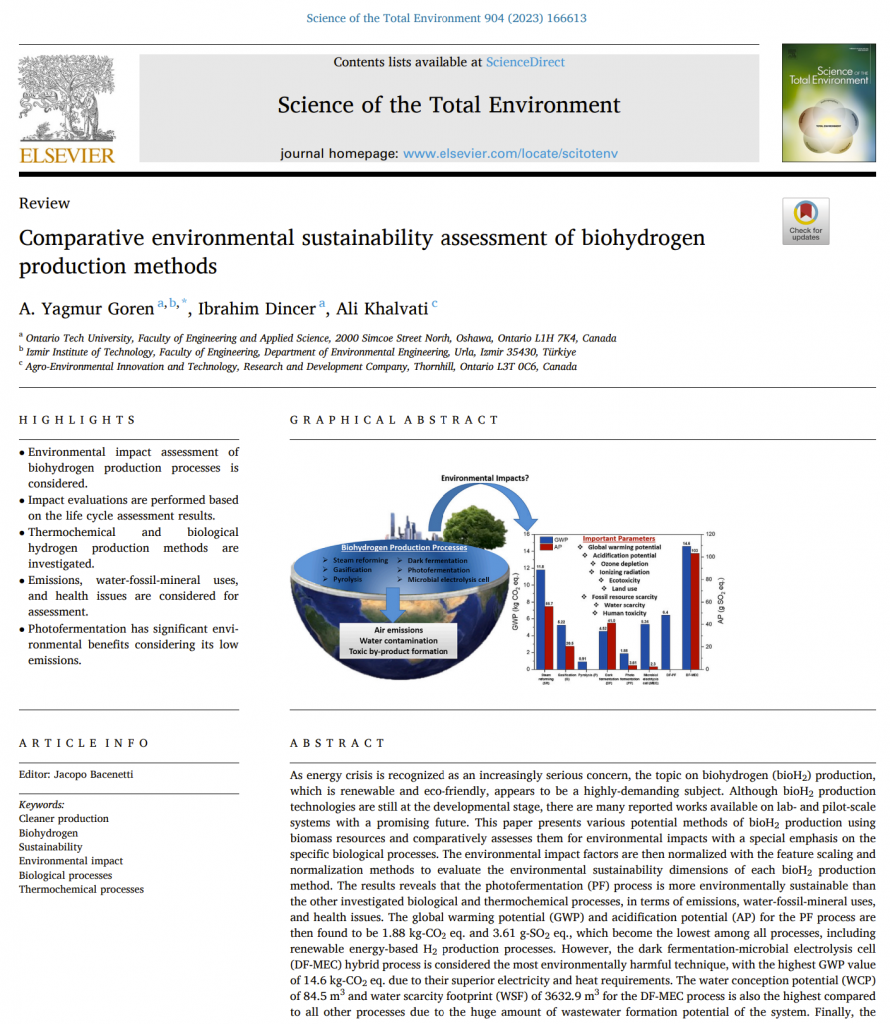
Comparative environmental sustainability assessment of biohydrogen production methods
Dr. A. Yagmur Gören Kara, our department’s Research Assistant, has published a review article in the Science of the Total Environment journal. The article focuses on assessing the environmental impacts of biohydrogen production technologies and was conducted during her postdoctoral studies at Ontario Tech University, in collaboration with fellow researchers from the same institution
In this study, environmental impact assessment of biohydrogen production processes is considered. These evaluations are performed based on the life cycle assessment results. Moreover, thermochemical and biological hydrogen production methods are investigated. Emissions, water-fossil-mineral uses, and health issues are considered for assessment during the investigation.
The study shows that photofermentation has significant environmental benefits considering its low emissions.
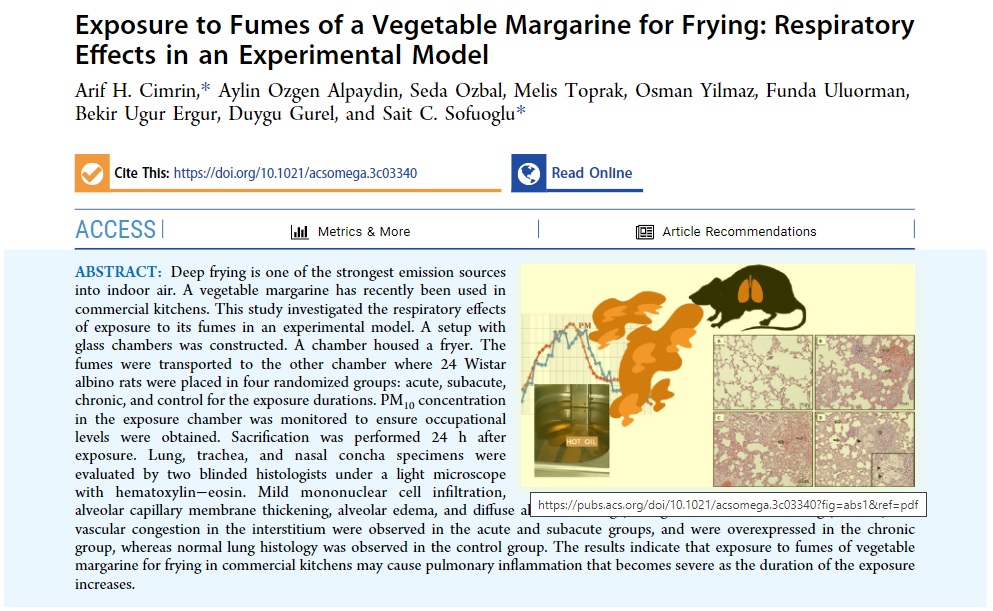
Exposure to Fumes of a Vegetable Margarine for Frying: Respiratory Effects in an Experimental Model
When the vegetable margarine used for frying in fast food kitchens is heated, it releases particles and volatile organic compounds into the air, which can result in pulmonary diseases for chefs. Additionally, frying other ingredients also increases the emission of particles and compounds.
Furthermore, studies have shown that asthma is more likely to develop in homes with open kitchens.
All of these factors emphasize the importance of proper kitchen ventilation and the use of stovetop exhaust hoods.
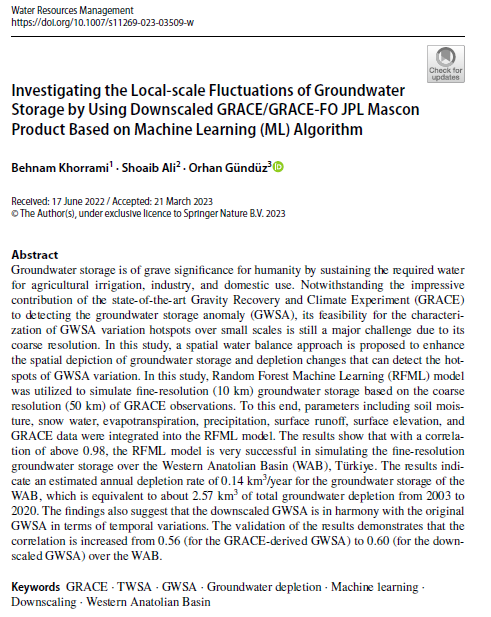
Investigating the Local-scale Fluctuations of Groundwater Storage by Using Downscaled GRACE/GRACE-FO JPL Mascon Product Based on Machine Learning (ML) Algorithm
Groundwater storage is crucial for sustaining water resources for agriculture, industry, and domestic use. While the Gravity Recovery and Climate Experiment (GRACE) has contributed significantly to detecting groundwater storage anomalies (GWSA), its coarse resolution presents a major challenge for characterizing GWSA variation hotspots at small scales. This study proposes a spatial water balance approach to enhance the spatial depiction of groundwater storage and depletion changes, allowing for the detection of GWSA hotspots. The Random Forest Machine Learning (RFML) model is utilized to simulate fine-resolution groundwater storage (10 km) based on the coarse resolution (50 km) GRACE observations. Parameters such as soil moisture, snow water, evapotranspiration, precipitation, surface runoff, surface elevation, and GRACE data are integrated into the RFML model. The results demonstrate that the RFML model successfully simulates fine-resolution groundwater storage over the Western Anatolian Basin (WAB) in Turkey, with a correlation above 0.98. The study estimates an annual depletion rate of 0.14 km3/year for the WAB’s groundwater storage, equivalent to a total groundwater depletion of approximately 2.57 km3 from 2003 to 2020. The downscaled GWSA aligns with the original GWSA in terms of temporal variations, as validated by an increased correlation from 0.56 (for GRACE-derived GWSA) to 0.60 (for downscaled GWSA) over the WAB.

Polyoxometalate-based hybrid composites in multi-functional wastewater treatment applications
The inorganic polyanionic clusters known as polyoxometalates (POMs) have several structural variations at the nanoscale scale. They have many uses in chemistry, materials science, medicine, and other fields. This review considers the developments in treating hazardous contaminants from wastewater using POMs-based compounds. Four main treatment methods using POM-based compounds to remove water pollutants have been developed: adsorption, photocatalytic treatment, Fenton-like treatment, and membrane separation. Moreover, we report the types of POMs, synthesis procedures, strategies to modify POM-based compounds, and their applications in wastewater treatment. To promote the development of these compounds for large-scale production and real-scale applications, gaps in knowledge and recent research obstacles are also pointed out. Most research on metal-organic complexes (MOCs) based on POM has focused on using these compounds as catalysts, with little focus on their additional uses. The adsorption and photocatalytic efficiency of modified POM-based compounds are attributed to their enhanced contaminant removal efficiency, and recovery of certain POM-based compounds by magnetic separation is presented as a promising option for their recyclability. This review is believed to provide an overview of recent advancements in POM-based compounds for water and wastewater treatment, offers thorough research to anyone interested in learning more about this topic, and acts as a manual for researchers working in this area.

Remote sensing-based monitoring and evaluation of the basin-wise dynamics of terrestrial water and groundwater storage fluctuations
In order to ensure the proper management of our country’s water resources, it is crucial to determine and monitor the storage levels of terrestrial water and groundwater sources. For this purpose, the Gravity Recovery and Climate Experiment (GRACE) satellite, developed by NASA and the German Aerospace Center, has been utilized to detect terrestrial water storage (TWS) fluctuations and groundwater storage (GWS) fluctuations in 25 basins in Türkiye between 2003 and 2020. The coarse spatial resolutions of the GRACE satellite have also been improved using a random forest algorithm model with a good performance. Our study identified the Doğu Akdeniz basin as the most sensitive among all basins, with an annual TWS change of 1.15 cm and a GWS change of 1.10 cm. When all basins are considered together, Turkey has experienced an average annual loss of 5.16 km3 of terrestrial water and 4.09 km3 of groundwater over the study period of 18 years. Furthermore, a partial correlation has been obtained between the net water flux obtained from the difference between precipitation and evapotranspiration and the water losses, indicating that anthropogenic factors also play a significant role in the spatial variability of water resources.
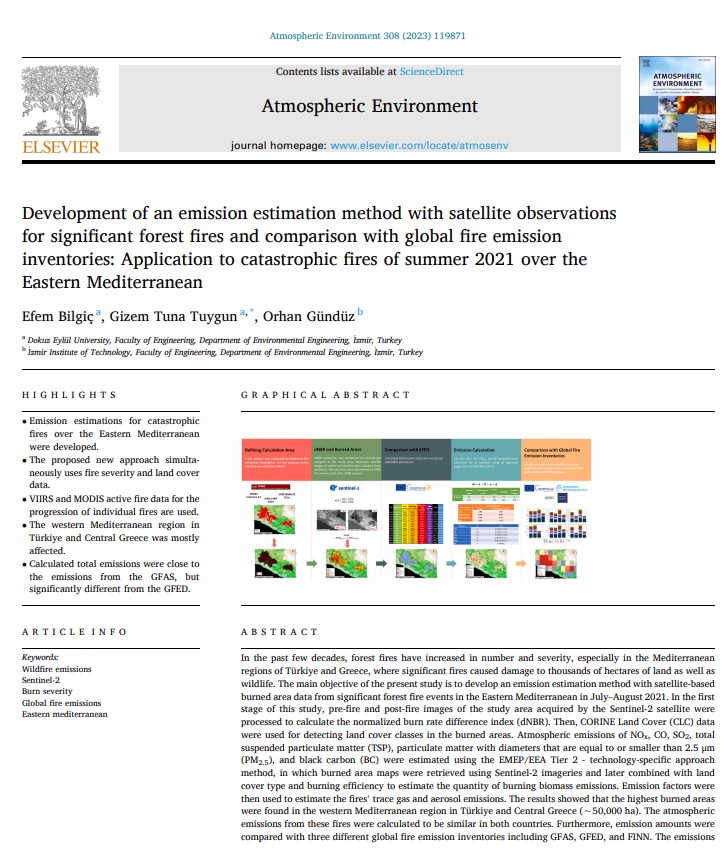
Development of an emission estimation method with satellite observations for significant forest fires and comparison with global fire emission inventories: Application to catastrophic fires of summer 2021 over the Eastern Mediterranean
The frequency and severity of forest fires in the Mediterranean regions of Turkey and Greece have increased, causing significant damage to the land and wildlife. The Western Mediterranean region in Turkey and Central Greece was affected by the burning of about 50,000 hectares of land. Comparisons with global fire emission databases showed that the study’s estimates were close to the GFAS database. To address this issue, a method has been developed to estimate emissions from devastating fires in the Eastern Mediterranean. The study calculates pollutant emissions such as NOx, CO, SO2, TSP, PM2.5, and BC using satellite data, fire severity analysis, and land cover information. The research highlights the importance of accurate emission estimates in understanding and addressing the environmental impacts of wildfires in the Mediterranean climate region. Using satellite data and a new emission calculation approach provides valuable information for future emission forecasting and air quality modeling applications.
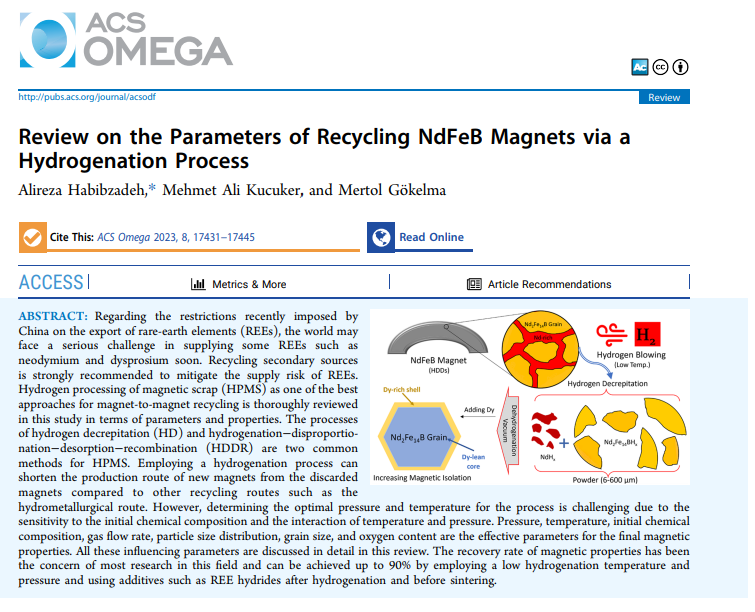
Review on the Parameters of Recycling NdFeB Magnets via a Hydrogenation Process
The increasing demand for rare-earth elements (REEs) such as neodymium and dysprosium, and the recent restrictions imposed by China on their export, has led to a serious challenge in the global supply of these critical raw materials. Recycling secondary sources is a promising solution to mitigate the supply risk of REEs, and hydrogen processing of magnetic scrap (HPMS) is one of the most efficient approaches for magnet-to-magnet recycling. This study provides a review of the parameters and properties of HPMS, focusing on the hydrogen decrepitation (HD) and hydrogenation–disproportionation–desorption–recombination (HDDR) processes. The review discusses the effective parameters for the final magnetic properties, including pressure, temperature, initial chemical composition, gas flow rate, particle size distribution, grain size, and oxygen content. The recovery rate of magnetic properties is a major concern in this field, and the review highlights the optimal conditions for achieving up to 90% recovery rate. The study also emphasizes the need for systematic waste collection to obtain clean, unoxidized, and disassembled NdFeB magnets. Overall, this review provides valuable insights into the challenges and opportunities of recycling NdFeB magnets via a hydrogenation process, which is a promising solution to reduce the supply risks of certain rare earth elements.
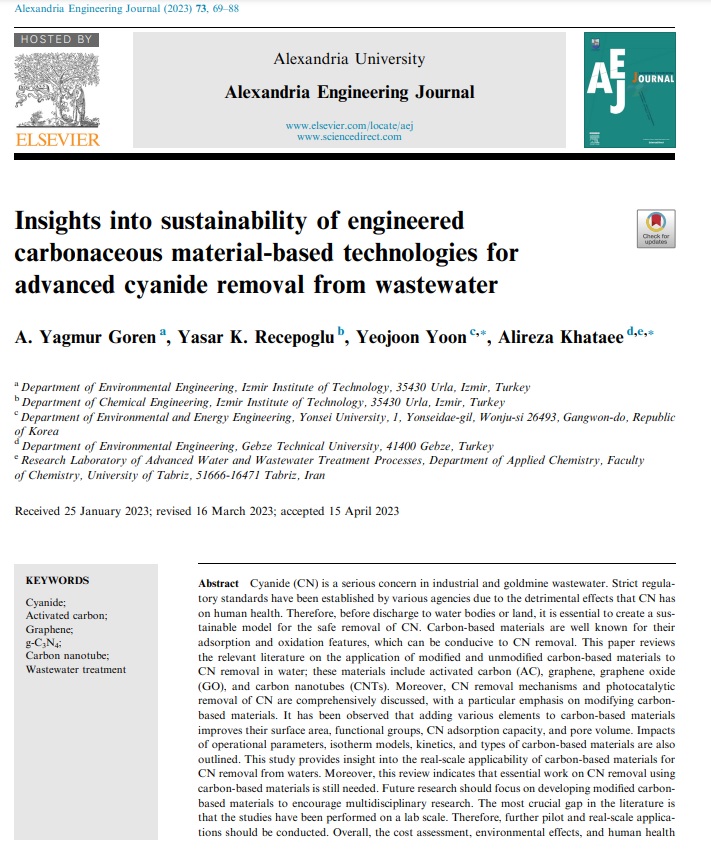
Insights into sustainability of engineered carbonaceous material-based technologies for advanced cyanide removal from wastewater
Cyanide (CN) is a serious concern in industrial and goldmine wastewater. Strict regulatory standards have been established by various agencies due to the detrimental effects that CN has on human health. Therefore, before discharge to water bodies or land, it is essential to create a sustainable model for the safe removal of CN. Carbon-based materials are well known for their adsorption and oxidation features, which can be conducive to CN removal. This paper reviews the relevant literature on the application of modified and unmodified carbon-based materials to CN removal in water. Moreover, CN removal mechanisms and photocatalytic removal of CN are comprehensively discussed, with a particular emphasis on modifying carbon-based materials. This study provides insight into the real-scale applicability of carbon-based materials for CN removal from waters. Moreover, this review indicates that essential work on CN removal using carbon-based materials is still needed. Future research should focus on developing modified carbon-based materials to encourage multidisciplinary research. The most crucial gap in the literature is that the studies have been performed on a lab scale. Therefore, further pilot and real-scale applications should be conducted. Overall, the cost assessment, environmental effects, and human health risks of carbon-based materials should be studied in future research to achieve a realistic perspective on applicability on an industrial scale.
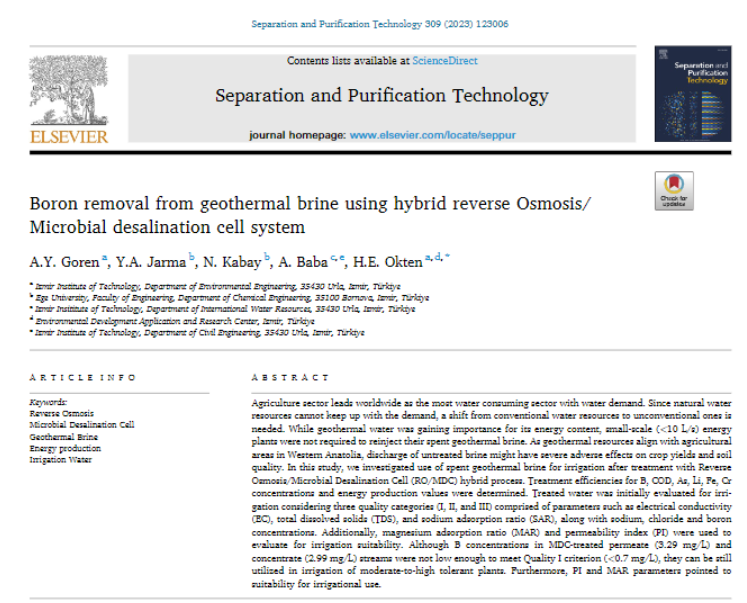
Boron removal from geothermal brine using hybrid reverse Osmosis/Microbial desalination cell system
Agriculture sector leads worldwide as the most water consuming sector with water demand. Since natural water resources cannot keep up with the demand, a shift from conventional water resources to unconventional ones is needed. While geothermal water was gaining importance for its energy content, small-scale (<10 L/s) energy plants were not required to reinject their spent geothermal brine. As geothermal resources align with agricultural areas in Western Anatolia, discharge of untreated brine might have severe adverse effects on crop yields and soil quality. In this study, we investigated use of spent geothermal brine for irrigation after treatment with Reverse Osmosis/Microbial Desalination Cell (RO/MDC) hybrid process. Treatment efficiencies for B, COD, As, Li, Fe, Cr concentrations and energy production values were determined. Treated water was initially evaluated for irrigation considering three quality categories (I, II, and III) comprised of parameters. Although B concentrations in MDC-treated permeate (3.29 mg/L) and concentrate (2.99 mg/L) streams were not low enough to meet Quality I criterion (<0.7 mg/L), they can be still utilized in irrigation of moderate-to-high tolerant plants.

Model-coupled GRACE-based analysis of hydrological dynamics of drying Lake Urmia and its basin
The Urmia Lake Basin (LUB) in northwest Iran is significantly degraded due to natural and anthropogenic factors. The basin is vital to the region’s microclimate, and its degradation threatens human and wildlife habitats. The study analyzed the hydrological dynamics of the lake and its basin by integrating satellite-based terrestrial water storage (TWS) data from the Gravity Recovery and Climate Experiment (GRACE) mission with hydrometeorological modeling and assessment tools. A new method called Seasonal-Trend decomposition using Locally estimated scatterplot smoothing (LOESS) is proposed to reconstruct missing TWS data. The analysis revealed that the LUB experienced an alarming hydrological situation from 2003 to 2021, with a total loss of 10 and 7.56 km3 from the TWS and groundwater reservoir, respectively. The lake’s water level also decreased at the rate of 70.21 cm/year, resulting in a total water loss of 13.35 m in the same period. The study highlights the urgent need to address issues to protect the well-being of residents and wildlife.
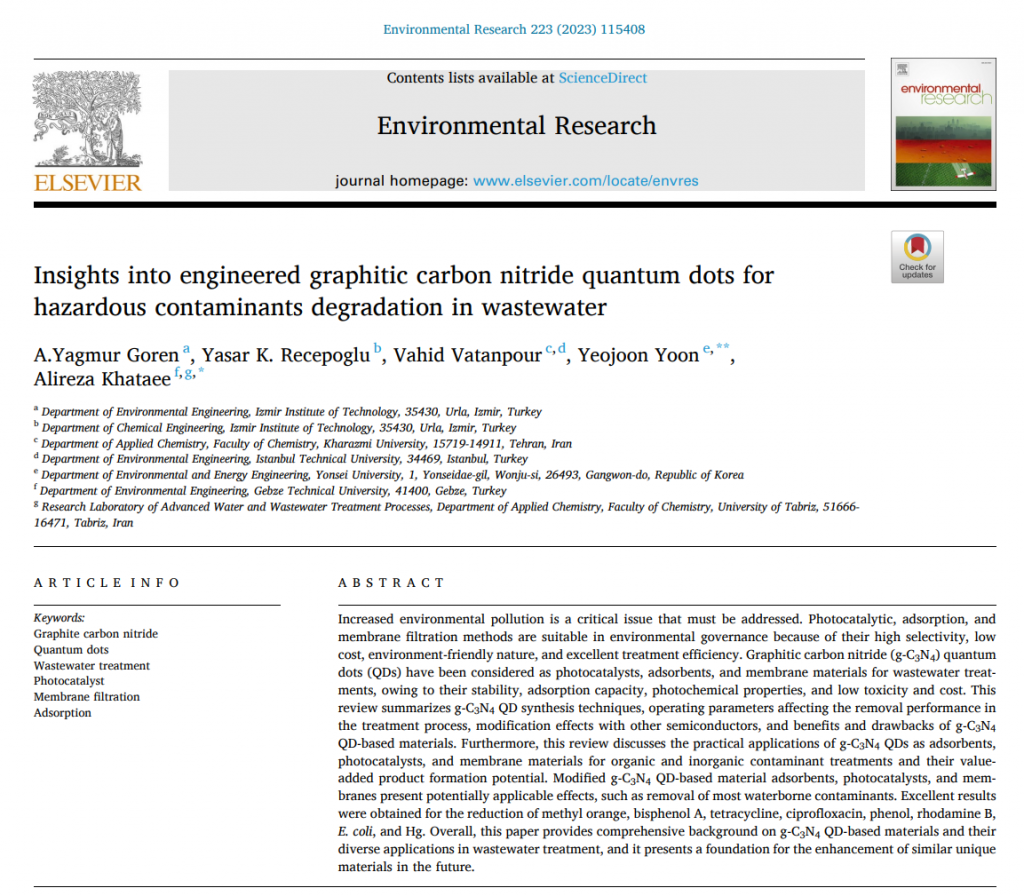
Insights into engineered graphitic carbon nitride quantum dots for hazardous contaminants degradation in wastewater
Increased environmental pollution is a critical issue that must be addressed. Photocatalytic, adsorption, and membrane filtration methods are suitable in environmental governance because of their high selectivity, low cost, environment-friendly nature, and excellent treatment efficiency. Graphitic carbon nitride (g-C3N4) quantum dots (QDs) have been considered as photocatalysts, adsorbents, and membrane materials for wastewater treatments, owing to their stability, adsorption capacity, photochemical properties, and low toxicity and cost. Modified g-C3N4 QD-based material adsorbents, photocatalysts, and membranes present potentially applicable effects, such as removal of most waterborne contaminants. Excellent results were obtained for the reduction of contaminants. Overall, this paper provides comprehensive background on g-C3N4 QD-based materials and their diverse applications in wastewater treatment, and it presents a foundation for the enhancement of similar unique materials in the future.
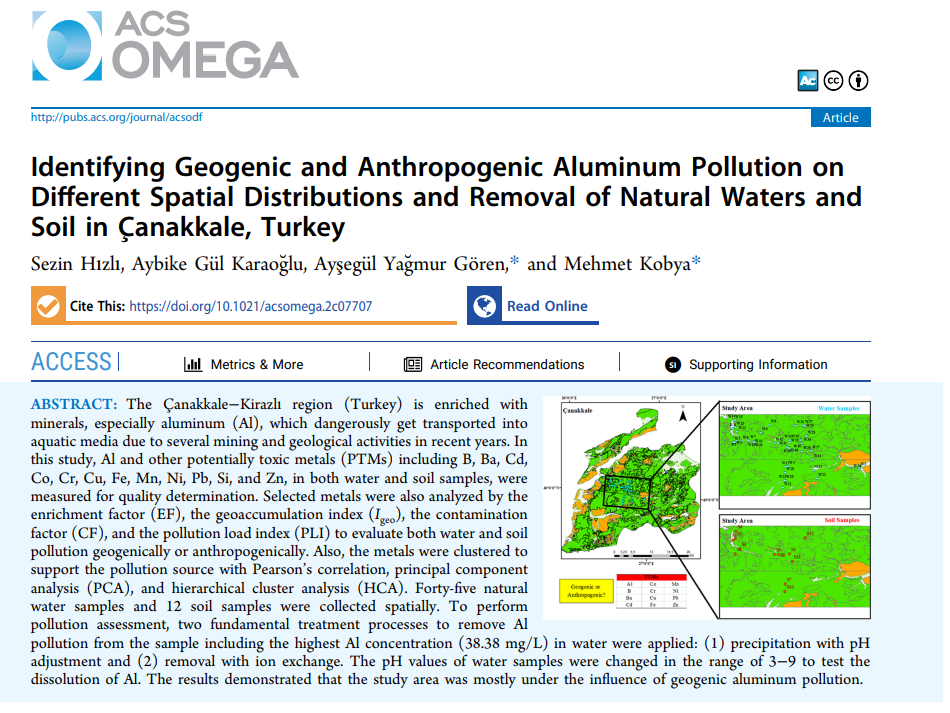
Identifying Geogenic and Anthropogenic Aluminum Pollution on Different Spatial Distributions and Removal of Natural Waters and Soil in Çanakkale, Turkey
The Çanakkale−Kirazlı region (Turkey) is enriched with minerals, especially aluminum (Al), which dangerously get transported into aquatic media due to several mining and geological activities in recent years. In this study, Al and other potentially toxic metals (PTMs), including B, Ba, Cd, Co, Cr, Cu, Fe, Mn, Ni, Pb, Si, and Zn, in both water and soil samples, were measured for quality determination. Selected metals were also analyzed by the enrichment factor (EF), the geoaccumulation index (Igeo), the contamination factor (CF), and the pollution load index (PLI) to evaluate both water and soil pollution geogenically or anthropogenically. Also, the metals were clustered to support the pollution source with Pearson’s correlation, principal component analysis (PCA), and hierarchical cluster analysis (HCA). To perform pollution assessment, two fundamental treatment processes to remove Al pollution from the sample, including the highest Al concentration (38.38 mg/L) in water were applied: (1) precipitation with pH adjustment and (2) removal with ion exchange. The results demonstrated that the study area was mostly influenced by geogenic aluminum pollution.
